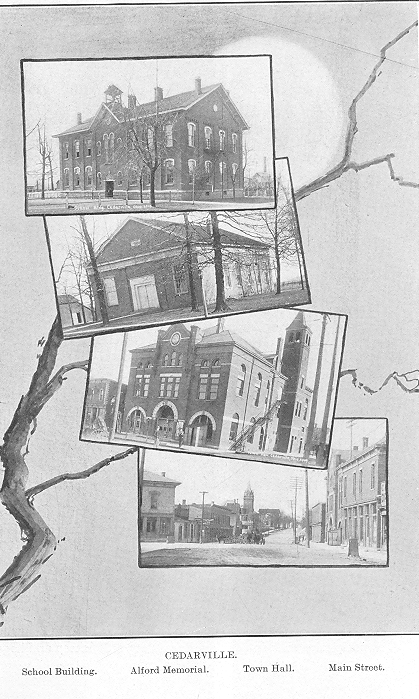
A DESCRIPTION OF THE COUNTY AND ITS TOWNSHIPS - 101
which have taken many a trophy. (See the article by O. E. Bradfute) .
Among the industries of the village are the elevators of D. S. Ervin and Kerr & Hastings Bros., the Ervin lime kilns, the Tarbox Lumber Co., and the Hagar Strawboard and Paper Co. The latter employs over sixty hands, makes a carload of paper a day, and hunts for straw as far as Kentucky.
But the greatest product of Cedarville Township is its citizens. Pioneers are always the soul of enterprise, else they would not become pioneers. Coming from the older settlements of the East, and been forced by the Scotch Covenanters, they put forth a civilizing energy which has not yet spent itself, but has been carried to greater heights by their descendants. Most prominent is the Hon. Whitelaw Reid, Ambassador to the Court of St. James, and for a third of a century editor of the New York Tribune. Without the honors which the world has bestowed, he would still by highly deserving as a model son, especially in the care he bestowed upon his widowed mother during her last years. As a mark of affection he keeps the old homestead in a condition that makes it a place of interest to visitors. from far and near. Many other sons of the township have been prominent iii civil life, among them being U. S. Senator James H. Kyle, Judge Samuel Kyle, and Gen. Robert Jackson.
Cedarville was well represented in the War of 1812 and the Mexican War, and in the Civil War she was the banner township of the banner county of the banner state, in the number of soldiers sent out.
JEFFERSON TOWNSHIP.
(Mr. R. C. Stewart, a blacksmith who has been at the same stand during the entire 60 years of the township's. history, is authority for the historical part of the following.)
Jefferson Township, in the southeast corner of the county, was organized in 1858, being taken from Silver Creek Township. The name was suggested by Peter Bowermaster, who was an ardent admirer of Thomas Jefferson. BOWERSVILLE, the only town, is situated on the C. & C. branch of the D. T. & I. Railroad,
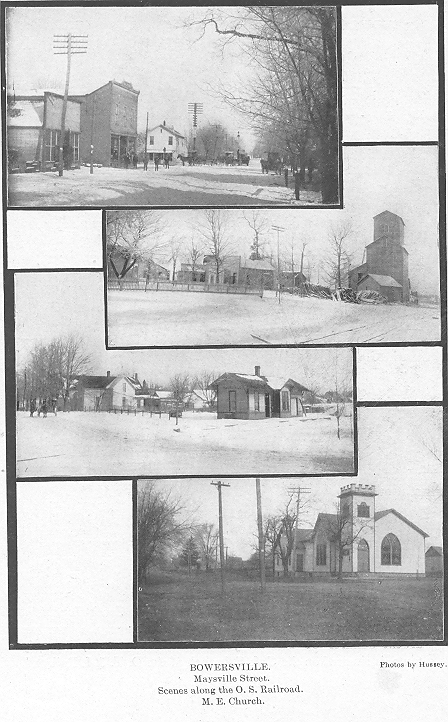
A DESCRIPTION OF THE COUNTY AND ITS TOWNSHIPS - 103
6 miles south of Jamestown and 15 miles from Xenia. At the time it was laid off by Chrigtopher H. Hussey and others, in 1848, there were three or four houses there. The name is said by some to have been taken from that of Peter Bowermaster, but in reality it was suggested by D. L. Reaves, who helped lay the town off, in reference to the abundant shade. In 1850 a M. P. church which was on the John Ross farm was moved to the town (a new building took its place about 25 years ago). A little later, a M. E. church (new building, 1902) and a Christian church (recently rebuilt) were established. Bowersville also has a six-room brick school building, a township house, post office, bank, sawmill, two elevators, two hotels, restaurant, livery stable, telephone office, barber shop, three blacksmith shops, and 12 stores. Population,. 1900, official, 370; 1908, estimated, 425.
MIAMI TOWNSHIP.
Charles H. Ellis.
Miami Township was organized June 8, 1808. It was formed from Bath and Xenia Townships and derived its name from the Little Miami River which flows through a considerable portion of its territory. This township is one of the most fertile in the State and contains a number of streams and considerable timber. Some of the finest natural scenery in the country is found along the banks of the Little Miami River and its tributaries. The township contains two villages, Clifton in the eastern section and Yellow Springs in the western.
Lewis Davis, whose home was near the big Yellow Spring on the Neff Grounds, is supposed to have been the first settler. He came here about 1799 and lived several years and surveyed considerable property. The first township officers were elected in 1816. In the early _times there were but few roads and these were scarcely traversable, The State road from Columbus to Cincinnati, via Clifton and Yellow Springs and Springfield was most generally used. In 1820 good land could be purchased from $3.00 to $6.00 an acre and laborers_ received 37 cents a day.
Grinnell's Mill is one of the few remaining landmarks of tie
104 - GREENE COUNTY 1803-1908.
early days and is still in operation by Mr. Frank Grinnell, Sr. A little farther up the river from Grinnell's is the famous Riverside Park now owned by Mr. John Bryan. This park contains over 500 acres of meadow, woods, river, springs and cascades.
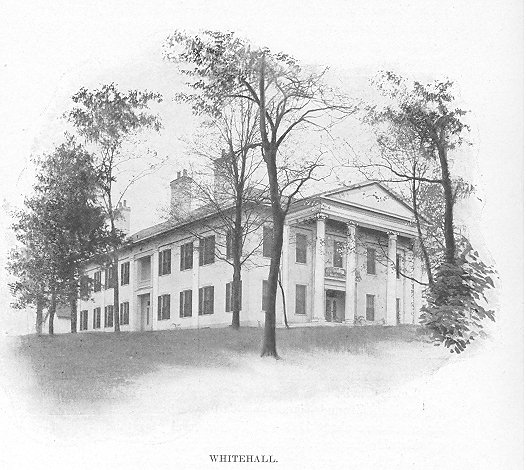
WHITEHALL.
The wildest and most beautiful scenery of the township is. located in this park along the Little Miami River. The largest farm barn in the State of Ohio is located at Riverside Park. It was built by Mr. Bryan. It is 206 feet long, 120 feet wide, 75 feet
A DESCRIPTION OF TIE COUNTY AND ITS TOWNSHIPS - 105
high. An L has been joined to the barn and it is about 85 feet by 50 feet. The first Story of the barn is built of stone and is a magnificent piece of Masonry. A part of the building contains five stories. It is equipped with running water and all modern improvements.
Whitehall, the present residence of Mr. E. S. Kelly, has been an ideal country home for over half a century. and its hospitility has always been in keeping with its halls and numerous spacious rooms and the extensive grounds surrounding it. It was built in 1846-7 after the Colonial style of architecture, similar to that of the White House at Washington. The house stands on high ground in the midst of a grove of handsome black walnut trees. From this grove was obtained the only lumber used in the erection of the house and for this reason the place for many years was known as Walnut Hall. At present the house is surrounded by a magnificent grove of young walnut trees covering a park of about twenty acres in extent. About 350 yards to the west lies a beautiful lake, making a landscape view as picturesque as can be found anywhere.
The main part of the. house is built of brick which were made in a kiln near by. The house was. erected by Judge Aaron H arlan and he frequently entertained many distinguished friends and guests. Mr., Kelly has remodeled it with many iniprovements. Many acres have been added to the original ,farM until it now contains 1100 acres of park and meadow, of woods and fields.
YELLOW SPRINGS.
On the northern border of the County, near the headwaters of the Little Miami River, is situated the beautiful and classical village of YELLOW SPRINGS, which takes its name from the celebrated yellow spring located in the famous Neff Grounds park. This spring is strongly impregnated with iron, magnesia, lime and silicious matter, and the iron gives a yellow tinge to everything over which it passes.
There is a mystic fascination about the place. The healing waters of the Yellow Spring were known to the Indians long before the first white settlers came to make their homes in the
106 - GREENE COUNTY 1803-1908.
wilderness. The flow of water is nearly 110 gallons a minute, at a temperature always the same, winter and summer, and in the language of the Indians; "cool as the morning air and with the golden tint of the setting sun." A short distance east of the spring is a mound of stone and earth which is no doubt the work of a prehistoric race. It is now crowned with a summer house and always attracts the attention of visitors. The Indians who succeeded the Mound Builders evidently set a high value on the spring, for it was located midway between the two famous settlements of the Shawnees, namely Oldtown, five miles to the south, where were located their most valued corn fields; and Mad River village, six miles to the north, where the famous Tecumseh was
A DESCRIPTION OF THE COUNTY AND ITS TOWNSHIPS - 107
born. The trail connecting these two points passed the spring and was plainly visible to the early settlers. It passed very near the present site of Antioch College and descended into the glen by a break in a rocky wall, which is still used for a foot path.
Lewis Davis was the first white man known to have lived here. He came from Cincinnati to Dayton on a trading .expedition in the year 1799, and while there he learned from an Indian of the great yellow spring and the beautiful country surrounding it. He immediately went to Old Town and followed the old Indian trail up to Yellow Springs where he camped for several days. In the fall of the year he built a log cabin a short distance east of the spring and surveyed considerable land in the surrounding territory. He often described the place to be a garden spot of health and beauty in a Vast wilderness. Other white men hearing of the marvelous grandeur of the place came and built cabins in this vicinity and the place was known as Forest Village. About 1820 General Whiteman laid off a number of lots north of the spring, which were named Ludlow. A number of log houses and several frame ones were erected., A sawmill was erected near the stone bridge. About this time there also appeared a colony of communists called Owenites, numbering over two hundred people. They erected a large ;building as a common residence, close to the cascade in the Neff Grounds. They worked in common and divided the proceeds of their labor equally, and in fact seemed to skim along in a rosy imagination of a self-established heaven-on-earth, where all things were equal and the luxuries as existing at that time belonged to the most common as well as the best. This free-for-all style however did not last long. Consequently, we find this colony of antitolstoic thinkers scattered to the four winds, after a residence of only two years. However, other people came to live in their places and in a short time there was quite a village built up here.
Among the Most prominent of the early settlers were Elisha Mills and his son, Judge William Mills. They owned large tracts of land in and around the village of Yellow Springs. In the year 1809 Elisha Mills erected a residence on what is now known as the. Old Yellow Springs House ground. It was afterwards

A DESCRIPTION OF THE COUNTY AND ITS TOWNSHIPS - 109
enlarged and used as a tavern, a Mr. Gardner being the first proprietor. Yellow Springs soon gained national prominence as a health and summer resort and thousands of people from all over the country came and visited here annually, to drink from the waters of the great yellow spring and enjoy the beauty of the cool groves and picturesque glens near by.
In 1853, Judge William Mills engaged the services of a surveyor and laid off a tract of land comprising 350 acres now included within the corporate limits of Yellow Springs. Lots sold at prices ranging from $150 to $500. Judge Mills reserved a tract of land comprising about twenty acres in the center of Yellow Springs on what is known as the Lawn, now occupied by Williams Means and his family. Judge Mills also donated grounds for schools and churches and he was called the founder of Yellow Springs. The village was incorporated in 1856 and Isaac Kershner was chosen as the first mayor. The village was laid out on a grand scale in which are thirty-seven streets, six of which are over a mile in length. The physical features of the village are unsurpassed anywhere. The Neff Grounds Park, .Sheldon's Glen, Taylor's Glen, Grinnell's Park, The Lawn or Means' Park, Glen Forest Cemetery and the Antioch College campus make Yellow Springs a beauty spot upon the face of Mother Nature. You will never find a place more richly endowed with natural beauty and healthful climate, with beautiful trees, glens, springs, cascades, cliffs and gorges than Yellow Springs.
It is not surprising that this place has attracted people from all parts of the country. Just opposite the village of Yellow Springs, two small streams unite whose waters a mile away empty into the Little Miami River. Through beds of limestone, in a deep ravine or glen, lies the course of these streams, skirted along-by high projecting cliffs and huge disrupted masses of rock, affording an enchanting variety of scenery. One of these outlying masses is known as Pompey's Pillar. Being an immense rock weighing fifteen or twenty tons, the upper surface almost as smooth and level as a table and easily accommodating twenty people, it affords a popular resort for visitors desiring a
110 - GREENE COUNTY 1863-1968.
view of the valley below. This stone is poised upon a pyramid of rocks about eighteen feet high.
Another curious formation in the Neff Grounds is the Devil's Wash Basin formed in solid rock in the bed of the stream a short distance above the "Cascade." It is twelve inches deep and six
A Bit of Natural Landscape Gardening on the Little Miami above Yellow Springs. feet in diameter with edges as smooth as if carved by hand.
A short distance below this basin is a cascade about twelve feet in height which affords a very pretty sight as the water goes leaping over the rocks into the deep ravine below, sending out a sparkling mist upon the ferns, flowers and fragrant honeysuckles hanging from the adjacent cliffs. Below the Cascade is the Magnetic Spring discovered after the flood of 1886. Further down the gorge is the old "Indian Silver Mine," which in former years
A DESCRIPTION OF THE COUNTY AND ITS TOWNSHIPS - 111
was worked considerably but never paid very well. Below this Mine two streams unite at a point known as Lovers' Lane. It consists of a lovely shady walk in the grove above, overlooking the two streams and affording a magnificent. landscape view.
On October 19, 1878, Messrs. Jesse Taylor and D. C. Duncan discovered the Antioch bone cave in the Neff Grounds, a short distance from Pompey's Pillar. It faces the south, is about four feet high and three feet wide, and extends into the cliffs about "fifteen feet. Skeletons of a child and of several kinds of animals were found therein. The child was supposed to belong to some prehistoric race.
The Lake in the Neff Grounds covers about ten acres. of ground and is a perfect gem set between high bluffs and wooded hills and is an attractive place for boating and bathing.
The Old Neff House was erected on a bluff near the Yellow Spring in 1840 and for years was crowded with visitors from all over the United States. It burned down in the sixties and a new Neff House was built in 1869-70. The new building was four and a half stories high, contained three hundred rooms, and cost over $100,000. It had quite a run for several seasons. In 1892
it was torn down and shipped to Cincinnati. Just south of the Neff Grounds is Sheldon's Glen in which, in 1848, the Water-Cure Hotel was erected by Drs. Chaney and Herman. This hotel was a famous health resort and enjoyed a national reputation for several years. It burned down in 1856 and was. never rebuilt.
In 1850 a convention of ministers of the Christian denomination assembled at Marion, New York, and after long deliberation decided to erect a college of high character. A committee was appointed to secure a location. Judge William Mills and a few citizens of Yellow Springs came to the front offering twenty acres of ground and $30,000 in cash to secure the College here. Their offer was accepted and the work began in 1852 and was finished in thirty-seven months. Horace Mann of Massachusetts was Chosen first president and under his leadership the institution flourished and gained national prominence: (See the article on Antioch College).
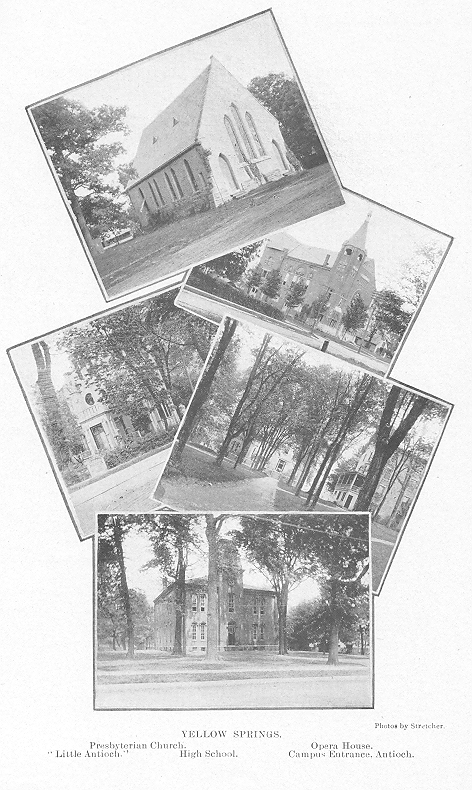
A DESCRIPTION OF THE COUNTY AND ITS TOWNSHIPS - 113
Mr. William Neff, of Cincinnati, purchased "The Glen," now known as the Neff Grounds, in 1841. He brought with him Mr. Frank Haffner, who acted as manager of the grounds for a great many years, Mr. Neff only spending a portion of his time ,here. The property has now passed into. the hands of Mr. Theodore Neff, who is conducting it as a picnic and pleasure resort
Of the early settlers of Yellow Springs, nearly all have passed to the Great Beyond. Mr. Samuel Cox, who was born here 75 years ago, is still living. He remembers when Yellow Springs was a vast wilderness when there was not a house between the old Yellow Springs House and the Currie place south of town. He has witnessed the growth of the village from a few log.huts to a modern up-to-date town with over four miles of cement sidewalks, electric railway, two telephone systems, telegraph lines, railroad, express, bank, modern postoffice with rural free delivery, opera house, fine college, good churches, schools, lodges and societies. There is a good prospect for natural gas. The streets are large and well shaded, the home commodious and comfortable and the people kind and hospitable.
The churches of the village are as follows : The Methodist Episcopal was organized in 1837 by Mr. and Mrs. Daniel Pennell, Mrs. Cox and David Potter, the meetings being held in houses, barns and groves. The first meetings were Conducted by Joseph Hill, Robert Cheney and others. In 1840 a building was erected on the northeast corner Dayton and Corry Streets and dedicated to Rev. Hammeline. In 1845-6 Judge William Mills and A. B. Johnson donated lots and money for a new edifice on Locust Street in exchange for the old building. A parsonage was built soon after.
The present Presbyterian church located on Walnut street was organized upon the request of Judge William Mills under the direction of the Dayton (New School) Presbytery by Rev. Samuel D. Smith, February 3, 1855. The church building was erected in 1859 and dedicated March 3, 1860. The church was legally incorporated as the First Presbyterian Church January 19, 1859.
The Christian church was organized in 1857-8 by Elder D. T. Ladley and a large brick church .was erected on the corner of
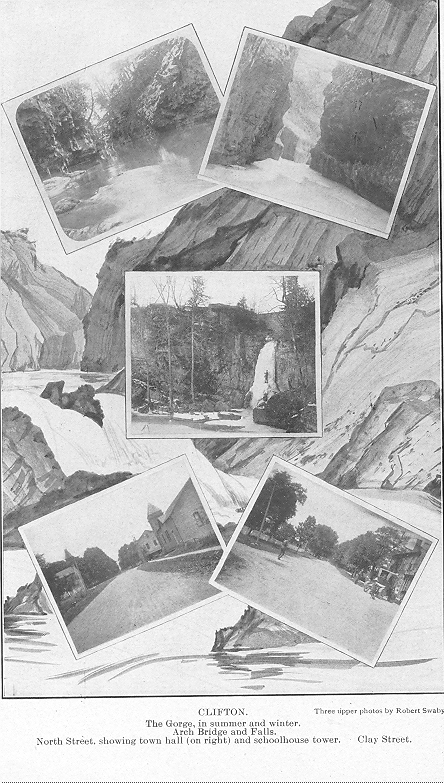
A DESCRIPTION OF THE COUNTY AND ITS TOWNSHIPS - 115
Davis and Elm Streets. The church has enjoyed great success in the past, but during the past few years so many of the leading members have died or moved away, that meetings have ceased to be held. The trustees a short time ago sold the church building to the Catholic denomination. The Catholics have been occupying a one-story brick church on High Street for a great many years, and their increasing numbers required a larger church.
There are two colored churches here, the Baptist and the African Methodist Episcopal. Both are well organized and have been in existence for nearly fifty years.
Yellow Springs is well equipped with societies. The Independent Order of Odd Fellows was•organized May 21, 1853 ; the Free and Accepted Masons No. 421 in August, 1868; F. A. A. M. Fountain Lodge 35, in 1872 ; Grand 'United Order of Odd Fellows, No. 1979, in 1881; Grand Army of the Republic, 1881; Woman's Relief Corps, 1894; Pride of Solomon Lodge, No. 39, June 27, 1903 ; Junior Order of United American Mechanics, 1901; Public Library Association, March 1, 1899. All are active and doing good work in their respective positions.
CLIFTON
DR. D. E. SPAHR
The village of Clifton derives its name from the continuous beautiftil cliffs that constitute the rocky gorge of the Little Miami River. It is the oldest town in Miami Township and contains a population of about 300., It was laid out in 1833 by Robert Watson, surveyor, and Timothy Bates and Bennett Lewis, original proprietors. The land was purchased for General Patterson who at that time owned a mill on the river at the present site of Clifton. The propelling facilities were all that could be desired and soon a distillery, saw mill, and flour mill were in operation. Being located on the Cincinnati, Lebanon & COlumbus stage route, the-new town was accessible to the outside world. It was incorporated in 1835. Failing to get the railroad from Xenia to Springfield was its Waterloo from which it has never recovered. At one time it bid fair to be the most prosperous business town in
116 - GREENE COUNTY 1803-1908.
the county. The most noted pioneer character was Gen. Benjamirr Whiteman, who was a brave soldier, noted Indian fighter and commissioner, who built the first court houle in Xenia and whose old homestead, the old stone house at the big spring east of Clifton, is still standing.
Clifton has at this time three churches, a Presbyterian, a United Presbyterian, and a Methodist Episcopal. The city building is a much more pretentious building than is usually found in villages of this size. It is a brick structure with mayor's office and lockup downstairs, and J. 0. U. A. M. Hall upstairs. The Opera House, a first-class little theater, has a stage 42 feet wide and a seating capacity of 500—a first-class opera seat for every man, woman and child in the village and 200 of their friends. The school house is a commodious brick structure of two stories, with four teachers. The churches are commodious and up-to-date. The town boasts of three general stores, two blacksmith shops, barber shop, restaurant, notary public, two prosperous phySicians, a flourishing K. of P. lodge, a J. 0. U. A. M. with a good membership, and a Grand Army Post. The village is properly laid out and is beautiful for situation, and is a delightful place to pass the simple life. The people are quiet, intelligent, and hospitable. Many distinguished people who have been associated with Clifton scenery in their youthful days are constantly returning to admire and enjoy the scenes still so dear to their hearts.
THE ROCKY CANYON AT CLIFTON.
To fully appreciate the beauty and grandeur of the picturesque Rocky Gorge at Clifton we should make at least two separate visits and explorations. One of these should be in the depth of winter, when the massive rocks are stripped of their summer covering and stand out grim, cold, and silent; when the door of each dark cavern stands open, when each rock, column and embankment stands rugged and magnificent before you and your voice echoes and reverberates throughout the solemn loneliness of this miniature canyon. Then again We should behold it as we shall today, in early June, bedecked in summer garb, arrayed in the drapery of green leaves and creeping vines and flowering
A DESCRIPTION OF THE COUNTY AND ITS TOWNSHIPS - 117
plants that add much to the loveliness but detract from the apparent depth and breadth and obstruct our observation.
Standing at the breast of the mill dam, at the edge of the village, we observe the winding course
of the river, as it flows peacefully through a comparatively level, almost flat, country—no rugged
mountains or hills in sight. Yet the peaceful water no sooner drops over the dam than it falls into
a deep gully which deepens and widens as it advances. Thus it stealthily glides along, skirting the
south and west of the village, secure and
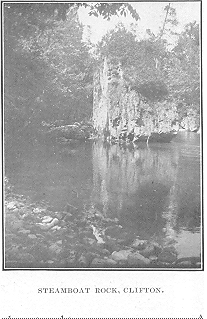
obscured in its almost subterranean passage. As we follow its winding course around the village we encounter first the old saw mill with its water power, a relic of antiquity ; then the arch bridge, the flouring mill, and numerous other scenes that bring the camera in the crowd into requisition. At the west of the village the old factory site, with the spring that issues from a cave under the Yellow Springs pike, is a subject for investigation: Here the channel deepens and narrows and the waters, com-
118 - GREENE COUNTY 1803-1908.
pressed from the sides and standing on edge plunge over the falls, spreading out into a deep dark pool, shaded, cool, and impressive. Here the "silent old boatman," long since gone to his reward, piloted his canoe loaded with appreciative sightseers enraptured with the soul-inspiring scene of the falls from below. Above these deep waters, where the towering rocky walls approximate each other, is the spot where tradition locates that mythical story of the wonderful leap of Simon Kenton, when to save his scalp he made the most astonishing jump on record and so escaped the noble red man.
A little further on, a depression in the side of the wall of the canyon is designated as the Devil's Armchair. Now we have reached the Cedar Garden, a beautiful grove in the widened chasm. Here are the twin Arch Bridges. A painting of the first one adorns the drop curtain in Xenia's opera house ; from beneath the other a little stream falls over the remains of the Jug Handle famed in story by Captain Howard many years ago.
Now the Steamboat Rock and Big Spring claim our admiration. Then the old paper mill location and the Blue Hole attract us for awhile, but the Brightest and Best, the ideal camping grounds and cool spring allure us into resting and refreshments, leaving numerous caves, Brewer's Springs and Cutlass Hole, and Bryan's Riverside camping grounds for the afternoon.
In a word, no spot in Ohio has more beauty and attractiveness for the sightseer, or charm for the piscatorial sportsman or sentimental, lover, or information for the geologist, botanist, or philosopher. These delightful cliffs have quietly and unpretentiously won their fame—a fame that is as substantial and enduring as their own unalterable rocks.
NEW JASPER TOWNSHIP.
This township was created in 1853 out of portions of Cedarville, Ross, Silver Creek, Caesar's Creek and Xenia Townships. NEW JASPER, the only town, is about 70 years old and has a population of something less than 100. It contains a township house, a Methodist EPiscop.1 church (both of brick and built in 1882), two stores, and a blacksmith shop. There is also a hall

120 - GREENE COUNTY 1803-1908.
where the Junior Order and the Daughters of America hold their meetings. On the .eastern edge of the township is the Caesar's Creek Baptist church. There are also in the township a tile factory, a sawmill, and two extensive limestone quarries which yield excellent building stone. (For a view of New Jasper, sec Caesar's Creek Township.)
ROSS TOWNSHIP.
Ross Township, the northeastern corner of the county, was organized in 1811. It is a very fertile area devoted largely to the raising of corn and the feeding of stock, but without incorporated towns. Part of it was originally prairie and much of its soil is black. Two small communities within its limits, GRAPE GROVE and GLADSToNE, have each a school, a church of Christ, a grocery, and a blacksmith shop. Most of the trading- is done in Jamestown and Cedarville.
SILVER CREEK TOWNSHIP.
This township was organized in 1811 and included all the southeastern corner of the county until the formation of Jefferson Township in 1858. It now contains but one town, Jamestown. MECHANICSILLE, two miles south of Jamestown, is merely a crossing of the roads where formerly were a store and blacksmith shop.
JAMESTOWN was laid out and recorded in 1816 and so named for James Browder, an early pioneer farmer of the locality. The site was originally owned by Thomas Browder and Martin denhall. The earliest enterprises that are recalled are the wool-carding mill of James Hodges, and Merrick & McBride's still and grist mill. The proprietors of these enterprises together with most of the farmers in the locality were immigrants froth Carolina and Virginia. The selection of the site of the town was a happy one; it is 16 miles from Wilmington, 18 from Washington, and 12 from Xenia. This isolation, even with the traveling facilities of today, serves to mitigate the competition of the larger towns. It is to the large farming area whose trade it thus possesses that the town owes its steady prosperity and growth.
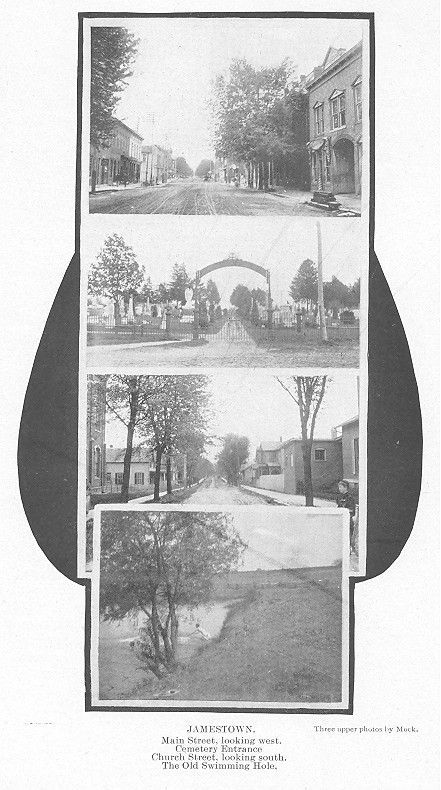
122 - GREENE COUNTY 1803-1908.
The region about Jamestown is a broad, level plain, extending for miles in every direction. The soil is a deep, rich, black loam that brings phenomenal prices.
There have been no spasmodic booms with their inevitable subsequent depression at Jamestown. The several attempts towards the commercialization of the oil, and gas of which the region gives indications have been too tentative to involve much loss.
In the spring of 1884. a cyclone destroyed nearly a third of the town, but the fact that there are no evidences of the disaster today exemplifies the industry and prosperity of the citizens. While there are no evidences of Jamestown's calamity, the abundance and quality of the farm produce that comes to its markets is still bearing record of Jamestown's greatest triumph, namely, the Jamestown Fair, which was started in 1860 and soon attained proportions second only to those of the Ohio State Fair. It was discontinued several years ago.
Today Jamestown's population is about 1500 (official, in 1900, 1205). Its industrial life is represented by two grain elevators, one flouring mill, one lumber yard, one cement block factory, one tile mill, one carriage factory, two banks, two newspapers, two hotels, three restaurants, three livery barns, two greenhouses, forty stores and shops of various kinds, and a commercial club. The town is situated on the Wellston division of the C. H. & D. Railroad.
Jamestown's social organizations are : Masons, I. O. O. F., O. E. S., G. U. O. of O. F., Junior Order, K. of P., M. W. of A., and the Ladies' Advance Club. There are nine churches and an opera house in Jamestown. The denominations represented ate: Baptist (2), M. E. and A. M. E., U. P., Church of Christ, Friends, Roman Catholic, and Christian.
The first characteristics that impress a visitor in the town are its beautiful deep verandaed homes and the city like appearance of its business section. It is Jamestown's unique good fortune to possess the tranquility of the village without its lethargy, and the industry of a city without its frenzy.
F; McD. T.

124 - GREENE COUNTY 1808-1968.
SPRING VALLEY TOWNSHIP.
This township was organized in 1856 from Sugar Creek, Caesar's Creek, and Xenia Townships. It is fertile, containing much bottom land, and is second only to Sugar Creek in tobacco production.
SPRING VALLEY, its chief town, is situated on a broad, level plain surrounded by a labyrinth of hills. The settlement, originally called Transylvania and consisting only of several houses, a general store, and the tavern and stage station of Jeffrey Truman, was on the west bank of the river, but with the construction of the Panhandle Railroad in 1845 the population shifted to its present center under the eastern range of hills.
Among the first industries were the pork packing and shipping company of Byrd & Walton, Barrett's woolen mill, Dougherty's linseed oil mill, and the large cooper shop of Giles Kinney. At present Spring Valley has a population of 700 (official, in 1900, 522). It has a flouring mill, two saw mills, a canning factory, a concrete block factory, three blacksmith shops, a national bank (surplus $60,000), a hotel, two restaurants, a poultry shipping house, two barber shops, and seven stores. Spring Valley's springs are its proudest possession. There are said to be fourteen different kinds of water within a radius of two miles. From one spring gushes a stream of water seven inches in diameter. "Magnetic" water flows from a pipe that was drilled for oil, while within ten inches of it strong medicinal water with no magnetic quality is ejected intermittently by the force of its own gas. This water comes from 1450 feet below the surface; it has about the same density as sea water and its chief . constituents are common salt and Epsom salts.
There are three churches in Spring Valley : the Methodist Episcopal (which in 1907 erected a new $8,000 church of concrete blocks), the Methodist Protestant, and the Friends'. A new school and high school building was also built of concrete blocks in 1907.
CLAYSVILLE, or ROXANNA, as it is now called, is a shipping point on the P. C. C. & St. L. Railroad. It is about two miles below Spring Valley, and the population is about 30.